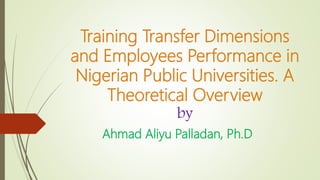
Training transfer dimensions and employees performance in nigerian
- 1. Training Transfer Dimensions and Employees Performance in Nigerian Public Universities. A Theoretical Overview by Ahmad Aliyu Palladan, Ph.D
- 2. Introduction Employees are major assets of any organization. The role that employees play towards organizational success cannot be overemphasized Several human resource theories are in supports of the essentiality of training which is considered as one of the criteria for achieving organizational goals by attracting and maintaining competent and committed employees (Chandra, 2020). One school of thought suggest that employees training leads to increase in turnover; while the other school argued that training can lead to higher levels of employee retention (Bibi, Ahmad & Majid, 2018).
- 3. Introduction (Cont.) Several universities fail because their employees are not well trained on skills that truly matter in this age of information and other global and local competitive challenges. Schulte and Kauffeld (2017) posited that through proper training transfer, Nigerian public universities can achieve the desired return on considerable investment on employees. A systematic and effective training program is driven by (1) comprehensive needs assessment in resolving organizational problems; (2) employing appropriate training contents and(3) delivery approaches; and evaluation of training handed out at the end of training programs, which influence the transfer of skills from training environment to work environment (Cheng , 2017).
- 4. Employees Performance In Nigerian Public Universities Pattanayak (2005), posited that employee performance connotes his resultant behaviour on assignments which could be observed and evaluated. The job performance of both academic and administrative staff in the Nigerian public university system is central issue that attracted government attention and scholarships. This culminated to the establishment of the National Productivity Centre (NPC), an agency under the Federal Ministry of Labour and Productivity (Agba & Ocheni, 2017). Again, the National University Commission (NUC) was established by the Nigerian central government in order to ensure quality and performance improvement in the Nigerian university system.
- 5. Performance in Nigerian Public Universities (Cont.) Performance of employees in public universities is a strong factor that determine the attainment of teaching, research and community services goals, which are the main goals of Nigerian public universities. Agba and Ocheni, (2017) posited that stakeholders in the education industry lamented that the job performance of academic staff in particular in some of the universities failed below the required standard It is generally believed by human resource gurus that training have positive impacts on employees job performance (Adagala & Michael, 2017; Palladan & AbdulKadir, 2016). All public universities in Nigeria send their employees for training from time to time in order to ensure performance improvement. But as been suggested by numerous empirical and anecdotal evidences, training alone will not be a panacea for employees’ performance problem
- 6. TRAINING TRANSFER DIMENSIONS Training transfer connotes the use of trained knowledge and skill back on the job (Burke & Hutchins, 2007) This paper proposed the adoption of four training transfer dimensions by the Nigerian public universities in order to poster their employees performance, which in turn will enhance their performance Cognitive Ability Self-Efficacy Motivation Personality
- 7. Conclusion This conceptual paper sought to recognize the need for training and development of the human resource in the public universities. This idea is congruent with the calls for sustainable economic development of the country This conceptual paper sought to recognize the need for training and development of the human resource in the public universities. This idea is congruent with the calls for sustainable economic development of the country
- 8. THANK YOU FOR LISTENING
